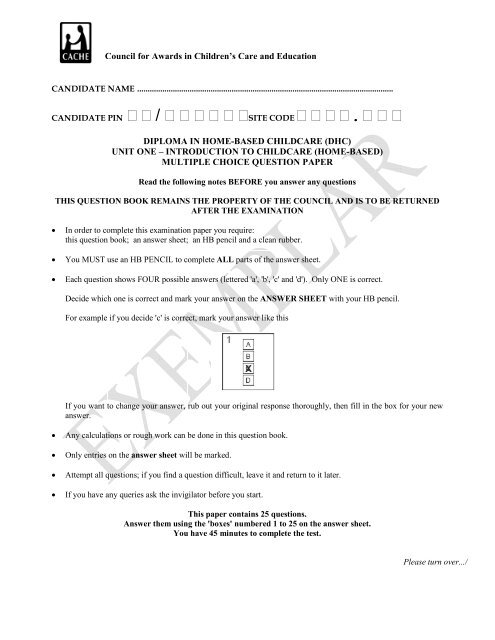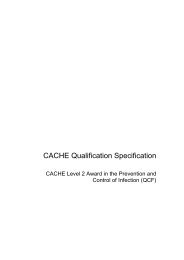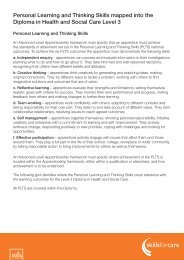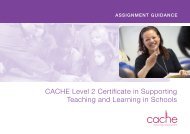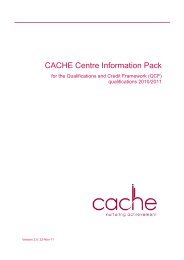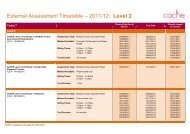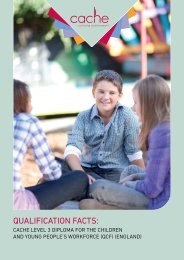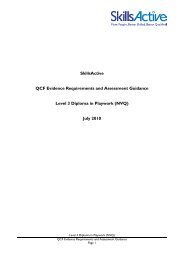Exemplar Test Papers - Cache
Exemplar Test Papers - Cache
Exemplar Test Papers - Cache
- No tags were found...
You also want an ePaper? Increase the reach of your titles
YUMPU automatically turns print PDFs into web optimized ePapers that Google loves.
1 A daily routine can provide a child withabcdtime to be noisya sense of securitylearning experiencesopportunities to explore2 What are the correct ways to use a safetyharness for a baby in a high chair?1 clean it after every meal time2 remove it if the child dislikes it3 adjust it to fit the child comfortably4 fasten it according to manufacturer'sinstructionsa 1,2 b 1,3c 2,4 d 3,43 A small fire starts in the kitchen whilechildren are in the setting. What should thepractitioner do FIRST?abcdcall the fire servicesevacuate the premisescollect the children’s recordsfind the children’s belongings4 Why is it important to know the sleep routineof a baby aged 9 months?1 to give continuity of care2 to meet the needs of the baby3 so the setting can be organised4 so the baby is awake for feeding timea 1,2 b 1,3c 2,4 d 3,45 The BEST play experience to promote grossmotor development is6 Physical play for children aged 2 years isMOST likely to promote1 listening skills2 a healthy appetite3 co-ordination and balance4 opportunities for sharinga 1,2 b 1,4c 2,3 d 3,47 A child aged 2 years can play safely with1 pan lids2 coat hangers3 wooden spoons4 gardening toolsa 1,2 b 1,3c 2,4 d 3,48 A practitioner who is planning activities forchildren should consider1 repeating the same activities regularly2 how activities will meet children’sdevelopmental needs3 the resources that will be needed forthe activities4 that children need to be physicallyactive throughout the daya 1,2 b 1,4c 2,3 d 3,49 Planning for a child’s play will be MOSTeffective if it is based on1 information from parents2 routines for rest and mealtimes3 observations by the practitioner4 activities the child can completeeasilyabcdpainting with spongescompleting a jigsaw puzzleplaying on a climbing frameusing play dough and cuttersa 1,2 b 1,3c 2,4 d 3,4
10 How can the practitioner BEST help a childaged 3 years to settle into the home-basedsetting?abcdreassure and comfort the childtalk to the parent at home timelet the child play without interruptionask another child to play with thischild11 What will help to ensure effectivecommunication with parents?1 value parents' opinions2 help parents to feel welcome3 encourage parents to telephoneregularly4 write down all conversations withparentsa 1,2 b 1,4c 2,3 d 3,412 How should the practitioner prepare for apossible change in the routine of a child aged3 years?1 make a poster about the new routine2 change the routine for one day aweek3 involve the child in planning the newroutine4 discuss the new routine with thechild's parentsa 1,2 b 1,3c 2,4 d 3,413 The BEST ways to support children andparents during the settling-in period are1 planning and implementing the sameroutine for each child2 explaining to parents that childrensettle quickly when they are left at asetting3 having flexible arrangements to meetthe needs of individual children andtheir parents4 acknowledging that parents may havefeelings of loss when they areseparated from their childrena 1,2 b 1,4c 2,3 d 3,414 A framework for behaviour is MOST likelyto help a child aged 3 years toabcdfeel securelearn through playenjoy outdoor activitiesunderstand daily routines15 How can the practitioner BEST respond tosome unwanted behaviour in a child aged 5years?abcdreassure the childdiscipline the childchange the play activitiesdiscuss the incident with the child16 A baby aged 6 months is distressed during thetransition to a new carer. The practitioner canBEST help the baby byabcdgiving regular praise andencouragementagreeing consistent care routines withthe parentsstaying with the baby at all times toreduce anxietyproviding stimulating experiences topromote development
Back CoverThis page may be used for notes if required but NOT for answers to be markedWarning - only answers on the correct answer sheet provided will be marked
<strong>Test</strong> Specification for CACHE Level 3 Diploma in Home-Based ChildcareMultiple Choice Question Paper<strong>Exemplar</strong> <strong>Test</strong> PaperQuestionNumberKey1. B2. D3. B4. A5. C6. C7. B8. C9. B10. A11. A12. D13. D14. A15. D16. C17. C18. D19. B20. C21. D22. A23. B24. B25. DNumber of marks achieved Grade15 or above Pass14 or below Referral
Diploma in Home-Based Childcare (DHC)Unit One – Introduction to Childcare (Home-Based)Multiple Choice Question Paper<strong>Exemplar</strong> Paper 2Read the following notes BEFORE you answer any questionsThis question book remains the property of the council and is to be returned after theexamination.• In order to complete this examination paper you require:this question book; an answer sheet; an HB pencil and a clean rubber.• You MUST use an HB PENCIL to complete ALL parts of the answer sheet.• Each question shows FOUR possible answers (lettered 'a', 'b', 'c' and 'd'). Only ONE iscorrect.Decide which one is correct and mark your answer on the ANSWER SHEET with your HBpencil.For example if you decide 'c' is correct, mark your answer like thisIf you want to change your answer, rub out your original response thoroughly, then fill in thebox for your new answer.• Any calculations or rough work can be done in this question book.• Only entries on the answer sheet will be marked.• Attempt all questions; if you find a question difficult, leave it and return to it later.• If you have any queries ask the invigilator before you start.This paper contains 25 questions.Answer them using the 'boxes' numbered 1 to 25 on the answer sheet.You have 45 minutes to complete the test.Please turn over.../© CACHE 1 DHC <strong>Exemplar</strong> Paper 2
1 The MOST important reason for providingphysical play opportunities is to promote5 Which activities support the developmentof fine manipulative skills?abcdreasoningbody growthverbal interactionsocial awareness1 story times2 musical games3 making sandwiches4 playing with interlocking bricks2 What is the BEST way to encouragechildren to rest during the day?a 1,2 b 1,4c 2,3 d 3,4abcdfollow the parent's routinesprovide a quiet area with cushionsask the children to rest at thesame timeprovide activities which use upenergy6 Daily routines that can BEST help a childaged 3 years learn to match objects are1 story times2 hand washing3 tidying away the toys4 setting the table for meals3 When the practitioner arrives to collect achild aged 7 years from school, the childhas been invited to go with anotherparent to play at a friend’s house.The practitioner shouldabcdaccompany the child to thefriend's housetell the friend that the child canvisit tomorrowtelephone the child's parent to askfor permissionexplain why the child must go withthe practitioner4 A child's routine should include periods ofrest or sleep to1 help the child to relax2 restore the child's energy levels3 allow time to prepare newactivities for the child4 avoid the child behaving in anegative waya 1,2 b 1,4c 2,3 d 3,4a 1,2 b 1,4c 2,3 d 3,47 What can a practitioner learn fromobserving a child playing?1 which toys the child likes to playwith2 what resources support the child'slearning3 how to record the child's play4 how parents play with the childa 1,2 b 1,3c 2,4 d 3,48 Play for children aged 3 and 4 years1 provides social experiences2 develops good personal hygiene3 makes sure they understandpositive behaviour4 encourages them to direct theirown activitiesa 1,2 b 1,4c 2,3 d 3,4© CACHE 2 DHC <strong>Exemplar</strong> Paper 2
9 Planning for a child’s play will be MOSTeffective if it is based on13 How can the practitioner support an olderchild who is cared for after school?1 information from parents2 routines for rest and mealtimes3 observations by the practitioner4 activities the child can completeeasilya 1,2 b 1,3c 2,4 d 3,4abcdencourage the child to playoutdoorsgive the child some specialresponsibilitiesmake sure the child has a drinkand a snacklisten when the child talks aboutthe school day10 Parents are MOST likely to choose ahome-based setting for their childbecause theyabcdneed cheaper childcareknow the practitioner's familyprefer a small caring environmentcan leave the child whenever theyneed to11 How can the practitioner support a childduring the settling-in period?1 encourage parents to stay for awhile2 provide new and challengingactivities3 gradually introduce the child tothe setting4 tell the child that the parents willsoon be backa 1,2 b 1,3c 2,4 d 3,414 A framework for behaviour is MOST likelyto help a child aged 3 years toabcdfeel securelearn through playenjoy outdoor activitiesunderstand daily routines15 How can a practitioner help children aged4 years to understand the rules andboundaries of the setting?abcddisplay a list of rules andboundaries for the settingwork with the children to agreethe rules and boundariesuse the same rules andboundaries as other settingsdevelop a policy for managingbehaviour16 A practitioner who is developing aframework for behaviour shouldalways consider12 It is MOST important for a practitioner towork in partnership with parents to1 promote the child's well-being2 involve the parent in planning3 build trust between practitionerand parent4 make sure the parentunderstands the setting'sproceduresa 1,2 b 1,3c 2,4 d 3,4abcdchanging the children's routineswhat rewards the children will likehow to treat all children in thesame waywhether the children willunderstand the boundaries© CACHE 3 DHC <strong>Exemplar</strong> Paper 2
17 The MOST effective strategy formanaging the challenging behaviour of achild aged 3 years is to21 What may a practitioner suspect if a childaged 4 years becomes withdrawnand fearful?abcdask the child to talk about feelingsprovide high quality playopportunitiesexplain to the child how thisbehaviour affects othersinclude the child in group gameswith rulesa abuseb illnessc neglectd prejudice22 Which describes emotional abuse?18 It is MOST important to provide individualspace for children's possessions toabcdkeep the setting tidygive each child privacyprotect children's rightshelp each child to feel valuedabcdregular lack of care of a childdeliberate physical ill-treatment ofa childconstant criticism of a child'sefforts and behaviourfailure to meet a child's physicalneeds and learning needs19 What is part of inclusive practice?23 A practitioner who suspects that a child isbeing bullied at school should FIRST1 meeting the individual needs of allchildren2 providing the same care for everychild3 making sure that all children do allactivities4 helping all children to reach theirpotentialabcdtell the child to talk to the teachermake an appointment to visit theschoolencourage the child to give moreinformationdiscuss any concerns with thechild's parentsa 1,2 b 1,4c 2,3 d 3,424 Information about a child may be sharedonly if20 Practitioners will be interested in theevents happening in the lives of thechildren in their care in order toabcdplan experiences easily andquicklykeep accurate records for parentscreate an environment wherechildren feel respectedkeep information which may beneeded for child protectionabcdthe child is invited to a partythe child's family moves to a newareathe child's parents have givenwritten permissionthe health visitor is providingsupport for the child© CACHE 4 DHC <strong>Exemplar</strong> Paper 2
25 What should the practitioner discuss withparents when negotiating a contract?1 tax and insurance2 terms and conditions of service3 ways to include parents' wishes4 day to day activities for the childa 1,2 b 1,4c 2,3 d 3,4THE END© CACHE 5 DHC <strong>Exemplar</strong> Paper 2
Back CoverThis page may be used for notes if required but NOT for answers to be markedWarning - only answers on the correct answer sheet provided will be marked© CACHE 6 DHC <strong>Exemplar</strong> Paper 2
Answer key for CACHE Level 3 Diploma in Home-based ChildcareMultiple Choice Question <strong>Test</strong><strong>Exemplar</strong> Paper 2Question KeyNumber1 B2 B3 D4 A5 D6 D7 A8 B9 B10 C11 B12 B13 D14 A15 B16 D17 B18 D19 B20 C21 A22 C23 D24 C25 CNumber of marks achievedGrade15 or above Pass14 or below Referral© CACHE DHC-L3 <strong>Exemplar</strong> Paper 2
Diploma in Home-Based Childcare (DHC)Unit One – Introduction to Childcare (Home-Based)Multiple Choice Question Paper<strong>Exemplar</strong> Paper 1Read the following notes BEFORE you answer any questionsThis question book remains the property of the council and is to be returned after theexamination.• In order to complete this examination paper you require:this question book; an answer sheet; an HB pencil and a clean rubber.• You MUST use an HB PENCIL to complete ALL parts of the answer sheet.• Each question shows FOUR possible answers (lettered 'a', 'b', 'c' and 'd'). Only ONE iscorrect.Decide which one is correct and mark your answer on the ANSWER SHEET with your HBpencil.For example if you decide 'c' is correct, mark your answer like thisIf you want to change your answer, rub out your original response thoroughly, then fill in thebox for your new answer.• Any calculations or rough work can be done in this question book.• Only entries on the answer sheet will be marked.• Attempt all questions; if you find a question difficult, leave it and return to it later.• If you have any queries ask the invigilator before you start.This paper contains 25 questions.Answer them using the 'boxes' numbered 1 to 25 on the answer sheet.You have 45 minutes to complete the test.Please turn over.../© CACHE 1 DHC-L3 <strong>Test</strong> Paper <strong>Exemplar</strong> Paper 1
1 A daily routine can provide a child withabcdtime to be noisya sense of securitylearning experiencesopportunities to explore2 What are the correct ways to use a safetyharness for a baby in a high chair?1 clean it after every meal time2 remove it if the child dislikes it3 adjust it to fit the child comfortably4 fasten it according tomanufacturer's instructionsa 1,2 b 1,3c 2,4 d 3,43 A small fire starts in the kitchen whilechildren are in the setting. What shouldthe practitioner do FIRST?abcdcall the fire servicesevacuate the premisescollect the children’s recordsfind the children’s belongings4 Why is it important to know the sleeproutine of a baby aged 9 months?1 to give continuity of care2 to meet the needs of the baby3 so the setting can be organised4 so the baby is awake for feedingtimea 1,2 b 1,3c 2,4 d 3,45 The BEST play experience to promotegross motor development is6 Physical play for children aged 2 years isMOST likely to promote1 listening skills2 a healthy appetite3 co-ordination and balance4 opportunities for sharinga 1,2 b 1,4c 2,3 d 3,47 A child aged 2 years can play safely with1 pan lids2 coat hangers3 wooden spoons4 gardening toolsa 1,2 b 1,3c 2,4 d 3,48 A practitioner who is planning activitiesfor children should consider1 repeating the same activitiesregularly2 how activities will meet children’sdevelopmental needs3 the resources that will be neededfor the activities4 that children need to be physicallyactive throughout the daya 1,2 b 1,4c 2,3 d 3,49 Planning for a child’s play will be MOSTeffective if it is based on1 information from parents2 routines for rest and mealtimes3 observations by the practitioner4 activities the child can completeeasilyabcdpainting with spongescompleting a jigsaw puzzleplaying on a climbing frameusing play dough and cuttersa 1,2 b 1,3c 2,4 d 3,4© CACHE 2 DHC-L3 <strong>Test</strong> Paper <strong>Exemplar</strong> Paper 1
10 How can the practitioner BEST help achild aged 3 years to settle into thehome-based setting?abcdreassure and comfort the childtalk to the parent at home timelet the child play withoutinterruptionask another child to play with thischild11 What will help to ensure effectivecommunication with parents?1 value parents' opinions2 help parents to feel welcome3 encourage parents to telephoneregularly4 write down all conversations withparents13 The BEST ways to support children andparents during the settling-in period are1 planning and implementing thesame routine for each child2 explaining to parents that childrensettle quickly when they are left ata setting3 having flexible arrangements tomeet the needs of individualchildren and their parents4 acknowledging that parents mayhave feelings of loss when theyare separated from their childrena 1,2 b 1,4c 2,3 d 3,414 A framework for behaviour is MOST likelyto help a child aged 3 years toa 1,2 b 1,4c 2,3 d 3,4abcdfeel securelearn through playenjoy outdoor activitiesunderstand daily routines12 How should the practitioner prepare for apossible change in the routine of a childaged 3 years?1 make a poster about the newroutine2 change the routine for one day aweek3 involve the child in planning thenew routine4 discuss the new routine with thechild's parentsa 1,2 b 1,3c 2,4 d 3,415 How can the practitioner BEST respondto some unwanted behaviour in a childaged 5 years?abcdreassure the childdiscipline the childchange the play activitiesdiscuss the incident with the child16 A baby aged 6 months is distressedduring the transition to a new carer. Thepractitioner can BEST help the baby byabcdgiving regular praise andencouragementagreeing consistent care routineswith the parentsstaying with the baby at all timesto reduce anxietyproviding stimulating experiencesto promote development© CACHE 3 DHC-L3 <strong>Test</strong> Paper <strong>Exemplar</strong> Paper 1
17 If the practitioner and parents agreeabout ways to manage behaviour, a childaged 3 years will be able toabcdunderstand hygiene routinesbe safe from abuse and bullyingbe confident in relating to adultsdevelop friendships with otherchildren18 It is important to provide individual spacefor children’s possessions toabcdkeep the setting tidygive each child privacyprotect children’s rightshelp each child to feel valued19 The effects of prejudice can result inchildren feeling1 lonely2 confident3 motivated4 insecurea 1,2 b 1,4c 2,3 d 3,422 What is the FIRST action if a practitionerstarts to suspect abuse to a child?abcdkeep an accurate recordtalk to the child's parentscontact Children's Servicesask the child some questions23 A practitioner can support a child whoexperiences bullying by1 helping the child to trust others2 creating opportunities fordiscussions to take place daily3 re-assuring the child that thesituation will soon improve4 maintaining a caring approachwhere the child feels valueda 1,2 b 1,4c 2,3 d 3,424 What is the BEST way to fill vacancies ina home-based childcare setting?abcdcontact local schoolsadvertise in the local areaproduce a colourful posterask parents to tell their friends20 A home-based practitioner is planning theday for three children aged between 1and 5 years from different families. It isMOST important to consider theabcdwishes of all the parentsresources available on that dayindividual needs of each childrequirements of the early yearscurriculum21 What may be a sign of physical abuse ofa child aged 12 months?25 The practitioner can maintain accuratefinancial records by1 estimating the possible income2 setting realistic fees for theservice3 recording income and expenditure4 keeping home and business costsseparatea 1,2 b 1,3c 2,4 d 3,4abcdthumb suckingfear of strangersaggressive behaviourbruising on the stomachTHE END© CACHE 4 DHC-L3 <strong>Test</strong> Paper <strong>Exemplar</strong> Paper 1


